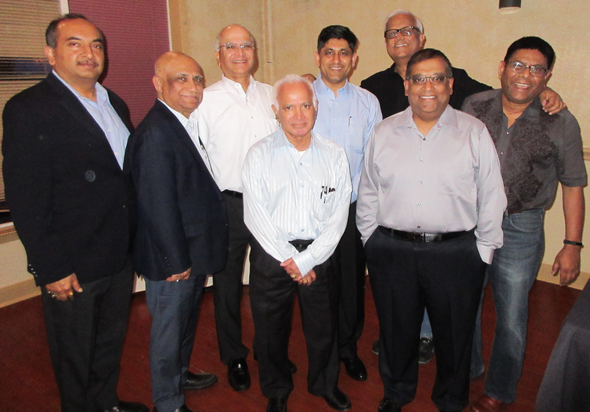Few Indian Universities in Global Ranking Prompts New Learning Model

At the April IITAGH meeting, from left, Jiten Agarwal, Surajit Dasgupta, Abhijit Gadgil, Malik Putcha, featured speaker Shailendra Kumar, Pradeep Anand, Partha Chatterjee and Tapan ‘TK’ Das.
By Jawahar Malhotra
SUGAR LAND: It wasn’t until he joined UCLA Berkley in 2006 and “took a deep dive into education” that he saw how multi-disciplinary universities functioned that he realized what his own education had been missing. As an administrator, he raised money, strengthened relations with communities, student bodies, US corporations and even Indian universities. And in the process, he understood how the faculties at large US universities were committed to research and excellence.
And that realization surprised Shailendra “Shail” Kumar because he was a graduate of the Indian Institutes of Technology’s Kharagpur campus, one of 23 IITs that stretch across India. These famed IITs are reputed the globe over for the caliber of their graduates who have no trouble finding work anywhere in the world. Many of them have catapulted to the helm of major multi-national corporations like Microsoft, McKinsey and Google. And IITians (as they like to call themselves) proudly refer to the segment in CBS’ 60 Minutes television program aired in 2012 which admiringly featured the IITs.
Kumar graduated from IIT-Karagpur in 1987 and later came to Indiana University in Bloomington to get an MBA. He moved to Silicon Valley in 1991 to work at FMC and Applied Materials, then later in 2002 to begin a start up in Houston, selling it after three years and move back to California. All along, he was very involved in the IIT alumni across the US, raising money and volunteering to help improve his alma mater. Kumar even helped set up the Pan-IIT Conference held in Houston in 2013.
“What I came to understand is that it was all rote learning at the IITs, like in most other Indian universities,” Kumar said in an interview in Houston in late April. “But the commitment to research that was applied to make an impact was missing. I saw this disconnect and that it was a very different, narrow-focused ‘silo’ mindset from US universities.”
He saw that US higher education was more integrated and multi-disciplinary. “It was a real gap!” he exclaimed. “There is tremendous value in the multi-disciplinary model as undergraduates are exposed to different subjects in the first two years, have the best faculties and student learning is greatly benefitted. And graduate students can tap into many faculties.”
With his training in research, Kumar delved into the workings of university systems and to his surprise discovered that 500 top World University Rankings, 135 were in the US, 45 in China, 12 in South Korea, 2 in Singapore and only one in India (the Indian Institute of Science in Bangalore).
He saw this as a significant gap, given that South Korea was an impoverished country only 6 decades ago. And out of this research, Kumar wrote a book entitled Building Golden India in which he expounds on a Nalanda 2.0 project, referring to Nalanda, the 1,400 year old ancient center of higher learning in India. The book analyses the problem and presents case studies and solutions. He worked full-time on the book for 18 months, and self-published it to escalate the problem and bring awareness to others.
Kumar’s Nalanda 2.0 project has a 501 c (3) non-profit status and he has a goal to raise $1 to $1.2 million to develop a master plan by next March for a private multi-disciplinary University of the Future in India. He already has a board of directors and an advisory council composed of many prominent titans of industry and education and his book has been presented to Indian Prime Minister Narendra Modi. He wants to start raising investment capital to build in two years.
Kumar was in town to expand on his book and his ideas at the monthly meeting of the local chapter of the IIT alumni at the Madras Pavilion on April 25 and a roomful of IITians came, many prepared with probing questions. Using Powerpoint slides, Kumar expanded on the ways that three ways that his ideas could have an impact and instead on focusing on state of Central government policy changes, he envisions a private university. A spirited question and answer session ensued, but slowly, the depth of his own realization started to permeate in the minds of his fellow IITians.
